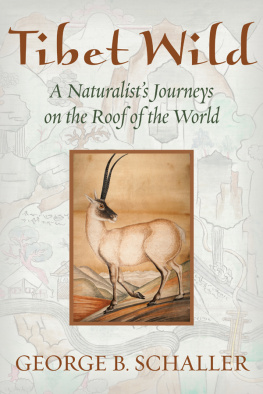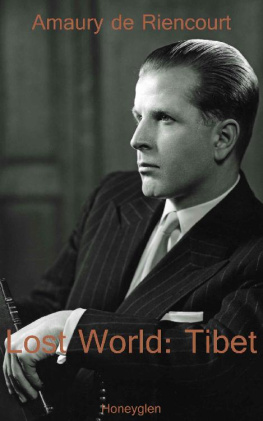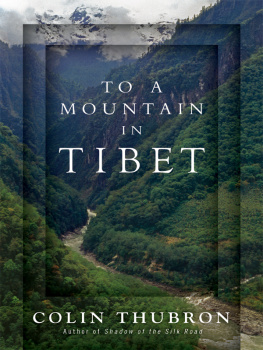Tibet Wild
Tibet Wild
A NATURALISTS JOURNEYS ON THE ROOF OF THE WORLD
George B. Schaller

Copyright 2012 George B. Schaller
All rights reserved under International and Pan-American Copyright Conventions. No part of this book may be reproduced in any form or by any means without permission in writing from the publisher: Island Press, Suite 300, 1718 Connecticut Ave., NW, Washington, DC 20009
ISLAND PRESS is a trademark of the Center for Resource Economics.
Library of Congress Cataloging-in-Publication Data
Schaller, George B.
Tibet wild : a naturalists journeys on the roof of the world / George B. Schaller.
p. cm.
Includes bibliographical references and index.
ISBN 978-1-61091-232-7 (ebook)
ISBN 978-1-61091-172-6 (cloth : alk. paper) ISBN 1-61091-172-5 (cloth : alk. paper) 1. Natural historyChinaTibet Autonomous Region. 2. Tibet Autonomous Region (China)Description and travel. 3. Tibet Autonomous Region (China)Environmental conditions. I. Title.
QH181.S35 2012
508.515dc23
2011049249
Printed on recycled, acid-free paper 
Manufactured in the United States of America
10 9 8 7 6 5 4 3 2 1
Keywords: Island Press, Tibet, China, Afghanistan, conservation, international conservation, wildlife conservation, naturalist, snow leopard, chiru
For my companions on these many journeys into the wild
This center of heaven
This core of the earth
This heart of the world
Fenced round with snow
The headland of all rivers
Where the mountains are high
And the land is pure
Tibetan poem, eighthninth century
Whatever happiness is in the world has arisen from a wish for the welfare of other beings.
Whatever misery there is has arisen from indulging in selfishness.
Buddhist precept
The World is sacred,
It cant be improved.
If you tamper with it,
You will ruin it.
If you treat it like an object,
You will lose it.
Laozi, Chinese philosopher, sixth century BCE
I am myself and
What is around me,
And if I do not save it,
It shall not save me.
Jos Ortega y Gasset, Spanish philosopher, twenty-first century
The chestnut by the eaves
In magnificent bloom
Passes unnoticed
By man of this world.
Basho, Japanese poet, seventeenth century
Introduction
F or nearly four decades my wife, Kay, and I have lived on North Americas East Coast beside a forest of maple and pine. Our house is a converted barn once used to stall cattle and dry tobacco. One half of the house consists of a huge, high room with the original barn beams still in place. It is our living room and the loft in it is lined with bookshelves crammed with travelogues, memoirs, histories, and expedition accounts about countries in which I have worked. But mainly it is a room of artifacts, of casual items acquired for their beauty, interest, or merely because they resonate in our hearts, each a memento of exploration and desire.
Wooden masks from the Congo and Nepal hang on a wall, as does a Masai shield of buffalo hide from Tanzania. A Dayak head-hunting knife from Sarawak is suspended from a beam beside an intricately woven basket from Laos used for collecting edible plants, land crabs, and other items for a meal. A shelf holds a stone adze from Brazil, a chunk of dinosaur bone from Mongolia, and a walrus tusk from Alaska with scrimshaw of seals and a polar bear. Against a wall stands a carved wooden chest from Pakistans Swat Valley. A brass bucket from Afghanistan holds firewood, and there is a lamp with a bronze base from India, and a photograph of Marco Polo sheep that reminds me of my studies in Tajikistan.
Of all the countries in which Ive worked, I spent far more years on projects in China than anywhere else. In 1980, I was invited to join a team of Chinese scientists in a four-year study of giant pandas, a venture arranged by World Wildlife Fund. After the conclusion of that project, I began field research on the high Tibetan Plateau of western China, and I continue with it still, drawn to the luminous landscape, the wildlife, and the Tibetan culture. Tibetan rugs cover the floor of our room. A large thangka, a scroll painting of Tara, the deity of loving kindness and compassion, covers part of one wall. Seven lacquered tsampa bowls, lovely in shape and design, used for storing barley flour, cover one table. On a shelf rests a prayer wheel, a tiny temple bell with crystalline sound, a cup for butter tea, and an incense box with two carved snow lions, their turquoise manes flowing, reminding us of Tibets snowy mountains. A large black-and-white photograph, taken over a hundred years ago, shows the Potala, the Dalai Lamas former home, on its hill overlooking fields and mountains beyond Lhasa.
The Tibetan Plateau has infected me, particularly the Chang Tang, the great northern plain. Chang Tang. The name enchants. It conjures a vision of totemic loneliness, of space, silence, and desolation, a place nowhere intimateyet that is part of its beauty. Even years before my first visit, I had long wanted to explore its secrets and, intrigued by the accounts of early Western travelers, I traced and retraced their journeys with a finger on a map. The Chang Tang was forbidden to foreigners, devoid of roads, and almost uninhabited; its inaccessibility enhanced its allure. In 1984 I finally had the opportunity to penetrate its vastness, an area which covers not just the northern part of the Tibet Autonomous Region, but also western Qinghai Province, and the southern rim of the Xinjiang Uygur Autonomous Region. By 2011, I had made twenty-six journeys to the Chang Tang for a total of about forty-one months, not counting wildlife surveys Ive also made in eastern Tibet and the Pamir Mountains of southwest China.
Though drawn to remote and little-known places by inclination, I also knew that the Chang Tang in northern Tibet and other parts of the Tibetan Plateau harbored a variety of large mammals, none of them studied, their lives still a mystery. Years of political turmoil had decimated Chinas wildlife, as I had noted during the panda study, and I wondered about the current status of various other species. Mainly I wondered how certain species of the Tibetan Plateau had fared. I wanted to delve into the lives of the Tibetan antelope (or chiru), the Tibetan wild ass (or kiang), the wild yak, and other members of the unique mammal community on these uplands. Initially the State Forestry Administration (called the Ministry of Forestry at the time) in Beijing suggested that I survey the distribution of snow leopard. This I did, but soon my attention shifted to chiru. The species intrigued me with its wanderings, here today and gone tomorrow. To know about the movements of an animal is a first step in protecting it. Little did I realize how many years it would require, at what cost in comfort and funds, and how many miles of uninhabited terrain we would have to traverse to obtain even a general idea of the chirus migratory patterns.
I approached the project as a scientist, more specifically as a biologist focused on conservation. This involved collecting facts, many of them, because they are the only reliable tool of science, and it is upon facts that conservation must ultimately be based. I do not mistake numbers and measurements and statistical detail for meaning, but I hoped to collect enough scattered facts to discover from them certain patterns and principles which underlie the Chang Tang ecosystem. But nothing remains static, neither a wildlife population nor a culture, and I knew my efforts would represent just a moment in time, a record of something that no one has seen before and never would again. My information offers the landscape an historical baseline, drawn over a three-decade period from which others working in the future can reclaim the past and compare it to their present. Because the Tibetan Plateau is being rapidly affected by climate change, the accumulation of such basic knowledge has now become especially timely and urgent.
Next page












